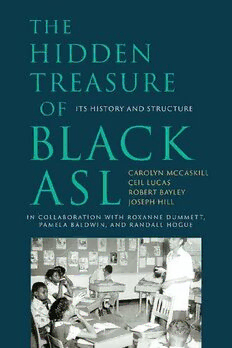
The Hidden Treasure of Black ASL: Its History and Structure PDF
Preview The Hidden Treasure of Black ASL: Its History and Structure
TThhee HHiiddddeenn TTrreeaassuurree ooff BBllaacckk AASSLL TThhee HHiiddddeenn TTrreeaassuurree ooff BBllaacckk AASSLL Its History and Structure Carolyn McCaskill Ceil Lucas Robert Bayley Joseph Hill in collaboration with Roxanne Dummett Pamela Baldwin Randall Hogue GALLAUDET UNIVERSITY PRESS / WASHINGTON, DC Gallaudet University Press Washington, DC 20002 http://gupress.gallaudet.edu © 2011 by Gallaudet University All rights reserved. Published in 2011. Paperback edition published in 2020. Cover design for paperback edition by Eric C. Wilder. On the cover: The Virginia State School for Colored Deaf and Blind, founded in 1909. Printed in the United States of America Paperback ISBN 978-1-944838-72-0 Ebook ISBN 978-1-944838-74-4 The Library of Congress has cataloged the hardcover edition as follows: The hidden treasure of Black ASL: its history and structure/Carolyn McCaskill . . . [et al.]; in collaboration with Roxanne King Pamela Baldwin Randall Hogue. p. cm. Includes bibliographical references and index. ISBN-13: 978-1-56368-489-0 (hard cover: alk. paper) ISBN-10: 1-56368-489-6 (hard cover: alk. paper) 1. American Sign Language. 2. African Americans. 3. Deaf—United States. 1. McCaskill, Carolyn. HV2545.H53 2011 419’.707—dc22 2010052968 The paper used in this publication meets the minimum requirements of American National Standard for Information Sciences—Permanence of Paper for Printed Library Materials, ANSI Z39.48-1984. There’s beauty in the way a hand Can carve a word on the air, There’s beauty in the way a hand Can give lift to a prayer. There’s beauty in the way a hand Can trace a song in space, There’s beauty in the way a hand Can light a deaf child’s face. Though we can’t hear the spoken word Or leaves rustling on a tree, We can hear the beauty Of a word that we can see. —Linwood Smith, “The Way of a Hand” Contents List of Illustrations ix List of Tables xiii Foreword xvii Glenn B. Anderson Preface xxiii Acknowledgments xxv Introduction 1 1. . The Sociohistorical Foundation 2 of Black ASL 14 . Research Methods 49 3 Signers’ Perceptions of Black ASL 64 4. Phonological Variation 75 5. Variation in Syntax and Discourse 109 6. The Effects of Language Contact 126 7. Lexical Variation 136 8. Conclusions 161 9. References 167 Supplementary Resources 183 Index 193 vii Illustrations Figure 1.1. Possible Distinguishing Features of Black ASL 10 Figure 1.2. Main Topics Addressed in This Study 13 Figure 2.1. A Cooking Class at the American School for the Deaf in Hartford, Connecticut (1906–1907) 16 Figure 2.2. The North Carolina State School for the Blind and Deaf 30 Figure 2.3. The “Colored” Department of the Arkansas School for the Deaf 32 Figure 2.4. Teachers and Students of the Madison Street School in 1950 33 Figure 2.5. The Asylum for Colored Deaf and Dumb and Blind Colored Youth 35 Figure 2.6. William H. Holland, the Founder of the Texas Asylum for Colored Youths and Orphans 35 Figure 2.7. The Alabama School for Negro Deaf and Blind in the Early Years 38 Figure 2.8. William Charles Ritter, the Founder of the Virginia State School for the Colored Deaf and Blind 42 ix
